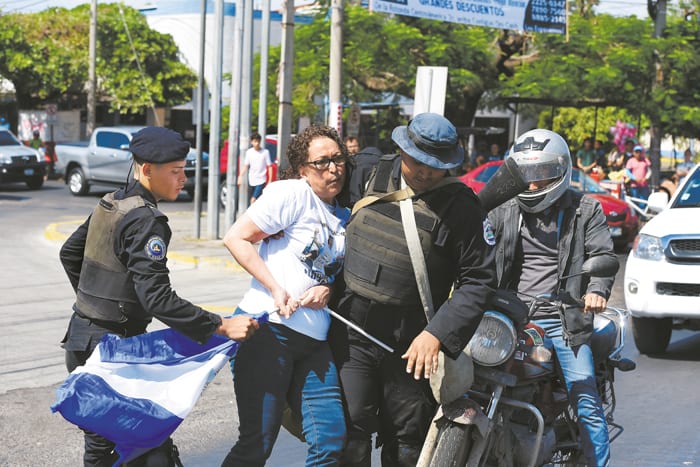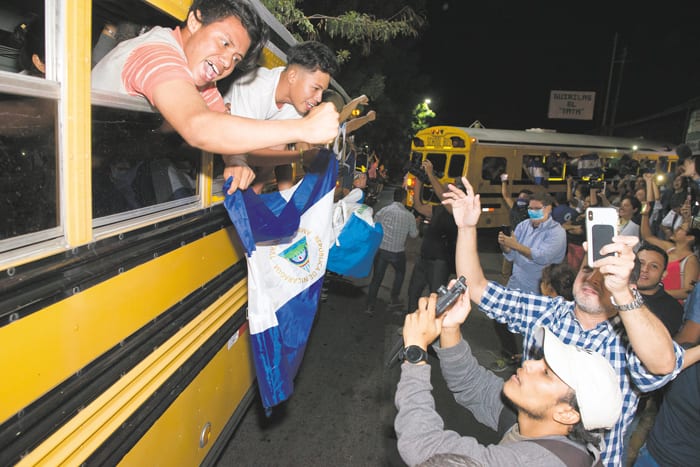Ortega Sent the Police to Lash Out at Citizens
The criminal repression left 164 people arrested during the demonstration

By Amalia del Cid (La Prensa)
HAVANA TIMES – The Ortega Police lashed out on Saturday against opponents and journalists in order to frustrate a march for the release of political prisoners. The day was marked by the brutality of the police and ended in the evening with the release of the people who were abducted, a total of 164 that were greeted by citizens who carried blue and white flags.
Citizens, journalists and even a priest suffered the violence unleashed by the Ortega regime against the peaceful demonstration. All of this happened despite the fact that the Government has expressed an interest in finding a way out of the crisis through dialogue.
In a single afternoon, the regime captured more people than the 162 who have been released into house arrest since last February 27.
In an official statement, the police said that the detainees on Saturday were 107 and that it “was forced” to make the captures “in defense of the security and rights of the citizenry.” However, the Blue and White National Unity coalition, which had announced the march, assured that the arrested citizens were 164.
City under siege
Managua this Saturday seemed like a city at war. To prevent the peaceful march, Daniel Ortega “released the police as if they were hunting dogs to capture defenseless citizens”, said political analyst Julio Lopez Campos, husband of ex-guerrilla commander Mónica Baltodano, one of those abducted yesterday, when she was heading towards the Central American roundabout carrying a blue and white flag.
The city awoke Saturday with a massive deployment of police with weapons of war and the attacks on potential demonstrators began thirty minutes before 2:00 in the afternoon, the time when the march was scheduled to begin.
The first person detained was a lone lady waving a small Nicaraguan flag on the Central American overpass. Journalist Luis Sequeira, of the AFP agency, recorded precisely this citizen when the riot police pushed him, broke his camera and stole his cell phone.
Minutes later dozens of riot police cornered journalists who were in the area who then took refuge on the property of the Lafise bank. Nearby, covering the kidnapping of demonstrators in Colonia Centroamérica was Cinthya Torrez, a journalist for the newspaper LA PRENSA, who was attacked by riot police who tried to take her cell phone.
“They did not even respect the men and women of the press. They stole cameras, telephones and even portfolios,” said indignant Pablo Cuevas, a lawyer of the Permanent Commission of Human Rights (CPDH).
Who are the criminals really? The Police that go out there assaulting or the citizens that simply carried a flag and the reporters with their phones and cameras to record the news?” she stated.
According to the lawyer, this Saturday the State of Nicaragua participated in a series of serious crimes and its reaction to citizen protests was “excessive, brutal, criminal and beyond any law.”
Nightmare in the Metrocentro Mall
The Metrocentro mall once again became the scene of Ortega’s repression. At 2:45 in the afternoon a horde of riot police entered this mall with violence and lashed out at the citizens who were trying to demonstrate, knocking them to the ground. The impressive videos circulated on social networks. They show the exaggerated number of policemen who persecuted citizens who carried the Nicaraguan flag and you see people who kneel in a show of pacifism.

There were wounded in the mall, but not even the Red Cross dared to remove them, said Cuevas. “They informed us that the Red Cross arrived and could not evacuate the wounded, because the Red Cross itself is afraid of being stopped by the police and the wounded citizen could be taken away when they transfer them to the hospital. We are like in a state of exception, where the constitutional rights of citizens were suspended,” said the lawyer yesterday afternoon.
Metrocentro remained under siege until 5:40 p.m., when the demonstrators finally could start to leave.
Before 9:00 at night the usually busy mall was emptier than a cemetery.
The Arrested
Among the detainees this Saturday afternoon were Azahalea Solís, Max Jerez and Sandra Ramos, members of the Civic Alliance. Also, the sociologist Sofía Montenegro, the feminist activist Marlen Chow (who made fashionable the phenomenon of the “red lips” protest) and Ana Margarita Vijil, former president of the Sandinista Renovation Movement (MRS).
Another known name on the list of detainees was that of Humberto Belli, former Minister of Education and brother of the writer Gioconda Belli. Sofana Arce was also captured along with her mother, Monica Baltodano. The young woman is also the daughter of Ortega politician Bayardo Arce.
In the raid young and old were arrested, and even a priest: Father Juan Domingo Gutierrez Alvarez, cousin of Monsignor Rolando Jose Alvarez, Bishop of Matagalpa.
Monsignor Silvio Baez, auxiliary bishop of Managua, wrote in on his Twitter account in solidarity with all those detained by the Police and especially with Father Juan Domingo. “He was arrested for peacefully carrying a [yellow and white] flag of the Church,” said Baez.
Protest in Matagalpa
On Saturday afternoon, a group of citizens held an express protest in the city of Matagalpa, despite the fact that the police deployed numerous patrols early on.
The sit-in was held about 200 meters north of the departmental police station and began with a group of approximately ten women who carried flags, who were then joined by more citizens.
When the police dispersed the protest, the protesters took refuge in the cathedral, where they sang national songs. Afterwards, little by little they managed to leave the church.





